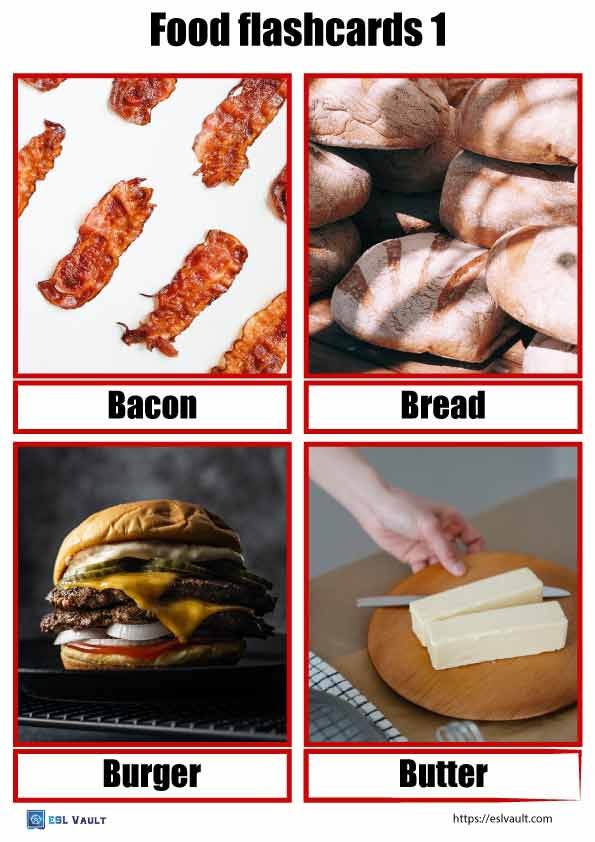Food flashcards
Here are some beautiful free food flashcards with real pictures that learners will find engaging. This resource is perfect for teaching young learners and ESL students food vocabulary. The food flashcards can be used in a lot of different ways, read below for some fun teaching ideas.
The cards do not include any foods that are fruit or vegetables, they can be found as separate sets here on ESL Vault. If you are looking for these, here are some quick links –
There are whopping 52 cards in this set. The foods featured by PDF page are –
- Bacon, bread, burger, and butter.
- Cake, candy, cereal, and cheese.
- Chicken, chocolate, cookie, and corn chips.
- Crab, donut, dumplings, and eggs.
- Fish, fries/chips, ham, and honey.
- Hot dog, ice cream, jam, and jelly.
- Lobster, lollipop, noodles, and nuts.
- Oil, pancakes, pasta, and pickles.
- Pie, pizza, popcorn, and ribs.
- Rice, salad, salmon, and salt and pepper.
- Sandwich, sausage, shrimp/prawn, and soup.
- Squid, steak, sushi, and taco.
- Tofu, tuna, waffle, and yogurt.
Ideas for using the free food flashcards
This flashcard set is quite large which means you will want to introduce parts of it slowly to young learners. The benefit of its big size is that it has a lot of vocabulary that can also be used for older ESL learners.
Here are a few teaching ideas that you might like to try!
- Matching. The cards have been designed in a way that lets you cut the words from the bottom of them. Once this is done you can shuffle the words and pictures and then ask students to match them correctly. Note that if you give them the full set it may take a fair amount of time to complete this!
- Likes and dislikes. For younger learners, you can use the cards to help them talk about foods that they like and dislike. Simple questions and answers are best to start with.
Printable food flashcards ideas continued
- Arranging. This is a particularly good idea if you are teaching about healthy and unhealthy foods. Students should arrange the cards into these two corresponding groups. For young learners, the cards can also be arranged in alphabetical order, or by color. Older students can arrange them into more complex ways such as food groups, the time of day or meal they are eaten as, flavors, and more.
- Meal planning. Another fun activity is to ask your class to use the food flashcards to plan a weekly diet. This can later be presented to the class as a speaking project.
- Speaking. The flashcards can be used for all manner of speaking activities. Depending on the flashcard, you can ask students things like how to cook or make some of the foods in the pictures. Other questions can be about what ingredients are in them, How often they eat them where they come from, etc. You can use them to pretty much ask anything about food!
















